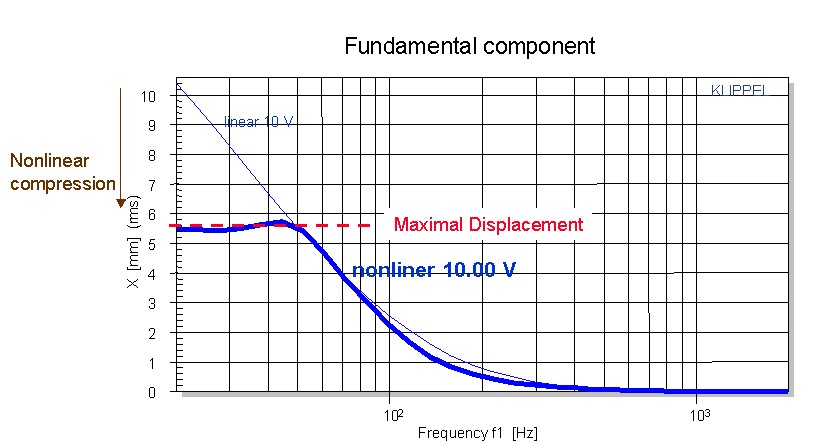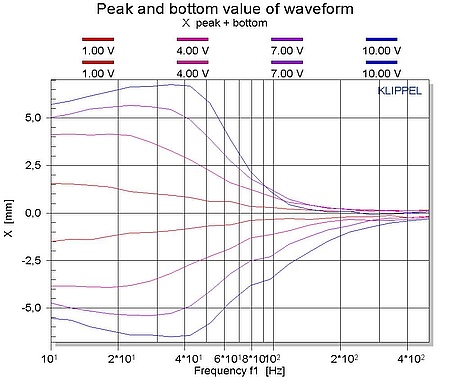Voice Coil Displacement
Characteristics: | KLIPPEL R&D System | KLIPPEL QC System |
|---|---|---|
| Transfer-function Hx(f)=X(f)/U(f) between voltage and displacement | LPM, TRF, SCN | TSX |
| Linear parameters (Thiele-Small) | LSI3, LPM, PWT, SCN, SPM | |
Nonlinear parameters | LSI3, SPM, PWT, | MSC |
| Peak, rms and dc displacement | MSC, DCX | |
| Rub & Buzz analysis | TRF PRO | SPL, SPL-IMP |

The direct measurement of the mechanical vibration by using a touch-less sensor is very important for designing, assessing and selecting transducers which are optimal in the final application. The measurement of the displacement by using laser triangulation sensor gives more relevant information than measuring velocity or acceleration. The dominant transducer nonlinearities limit the maximal peak displacement Xmax of the voice coil which is one of the most important single-valued characteristics describing the large signal performance and the maximal acoustical output at low frequencies. An asymmetrical shape of the loudspeaker nonlinearities generates a dc component in the voice coil displacement which cannot be detected in the differentiated signals (velocity, acceleration, sound pressure).
The figure to the left shows the amplitude of the voice coil displacement versus frequency. Below the resonance frequency, the nonlinearities of the transducer, such as the force factor Bl(x) and stiffness Kms(x), decrease the fundamental component below the value predicted by a linear model. The nonlinear compression can be measured by a laser sensor or predicted by using a large signal model and identified nonlinear parameters (SIM).

The figure to the left shows the positive and negative peak of the voice coil displacement for a terminal voltage which is increased in equal steps. For a sinusoidal stimulus of 10 Volts below the resonance frequency (fs= 50 Hz) the fundamental component is under compression and the displacement is 8 dB below the linearly predicted value. Above resonance asymmetries in the loudspeaker generate a dc component which shifts the voice coil by 2 mm to the negative side.
KLIPPEL R&D SYSTEM (development)
Module | Comment |
|---|---|
TRF measures the displacement transfer function Hx(f) at higher frequencies with sufficient SNR by using a shaped stimulus (emphasis by 10 dB/octave to higher frequencies). | |
LPM measures the displacement of the voice coil by using a multi-tone signal which gives the best SNR and generates a minimum of nonlinear distortion. This is important for a reliable measurement of the Thiele-Small parameter without perturbation technique. | |
| Large Signal Identification (LSI3) | LSI3 measures the peak and bottom displacement of the voice coil during all states of the transducer identification. As soon as the modelling parameters are available, the voice coil displacement will be estimated too. |
DIS module measures peak, bottom, rms value and dc components via frequency and input voltage. | |
SCN provides the mean value of the voice coil displacement averaged over the circumference of the voice coil. |
KLIPPEL QC SYSTEM (end-of-line testing)
Module | Comment |
|---|---|
| Motor + Suspension Check (MSC) | MSC task predicts the voice coil displacement based on the measured voltage and current signal using an imported Bl(x=0). |
| Sound Pressure Task (SPL) Sound Pressure and Impedance Task (SPL-IMP) | The SPL related tasks analyzes excursion signals providing a detailed displacement analysis (phase, fundamental, distortion). Note, that a proper laser sensor calibration is required. |
| Impedance Task (IMP) T/S Parameter Laser Fitting (TSX) | Closely related to the LPM, the IMP with TSX add-on analyzes 3 signals: voltage, current and voice coil displacement. Displacement spectrum and transfer function Hx(f) for chirp or multi-tone stimulus as well as derived T/S parameter are available.
|
| Dynamic Excursion Check and Control (DCX) | The DCX Add-On to the SPL task analyzes the envelope of excursion and the dynamic offset of the voice coil using an excursion sensor. Limits can be applied and compression and non-linear (instable coil position) effects can be detected. A KA3 hardware with DC coupled inputs is recommended. |
Example:
Templates of KLIPPEL products
Name of the Template | Application |
|---|---|
DIS X Fundamental, DC | Fundamental and DC component of displacement |
TRF H(f)= X/voltage | Transfer function H(f)= displacement(f) / voltage(f) |
TRF rubb+buzz w/o Golden Unit | Rub & Buzz detection without "Golden Unit" according Application Note AN 22 |
TRF rubb+buzz with Golden Unit | Rub & Buzz detection with "Golden Unit" according Application Note AN 23 |
DIS Compliance Asymmetry AN 15 | Checking for asymmetries caused by compliance according Application Note AN 15 |
DIS Motor stability | Checking motor stability at frequency 1.5 fs (where Xdc is maximal) according Application Note AN 14 |
LSI Tweeter Nonlin. Para Sp2 | Tweeters with fs > 400 Hz at sensitive current sensor 2 |
LSI Headphone Nonlin. P. Sp2 | Nonlinear parameters of headphones with fs < 300 Hz at sensitive current sensor 2 |
LSI Woofer Nonl. P. Sp1 | Nonlinear parameters of woofers with fs < 300 Hz at standard current sensor 1 |
LSI Woofer Nonl.+Therm. Sp1 | Nonlinear and thermal parameters of woofers with fs < 300 Hz at standard current sensor Sp1 |
LSI Woofer+Box Nonl. P Sp1 | Nonlinear parameters of woofers operated in free air, sealed or vented enclosure with a resonance frequency fs < 300 Hz at standard current sensor Sp1 |
LSI Microspeaker Nonl. P. Sp2 | Nonlinear parameters of microspeakers with fs > 300 Hz at sensitive current sensor 2 |
SIM closed box analysis | Maximal displacement, dc displacement, compression, SPL, distortion using large signal parameters imported from LSI BOX |
SIM Compression Out(In) | Output amplitude versus input amplitude at four frequencies using large signal parameters imported from LSI; Simulated results are comparable with DIS Compression Out(In). |
SIM Motor Stability | Checking motor stability according Application Note AN 14; Simulated results are comparable with DIS Motor stability. |
SIM vented box analysis | Maximal displacement, dc displacement, compression, SPL, harmonic distortion using large signal parameters imported from LSI BOX |
SIM X Fundamental, DC | Maximal displacement, dc displacement, compression using large signal parameters imported from LSI; Results are comparable with DIS X Fundamental, DC. |
AUR auralization | Real-time auralization of the large signal performance |
Diagnost. MIDRANGE Sp1 | Comprehensive testing of midrange drivers with a resonance 30 Hz < fs < 200 Hz using standard current sensor 1 |
Diagnost. RUB&BUZZ Sp1 | Batch of Rub & Buzz tests with increased voltage (applied to high power devices) |
Diagnost. RUB & BUZZ Sp2 | Batch of Rub & Buzz tests with increased voltage (applied to low power devices) |
Diagnost. SUBWOOFER (Sp1) | Comprehensive testing of subwoofers with a resonance 10 Hz < fs < 70 Hz using standard current sensor 1 |
Diagnostics MICROSPEAKER Sp2 | Comprehensive testing of microspeakers with a resonance 100 Hz < fs < 2 kHz using sensitive current sensor 2 |
Diagnostics TWEETER (Sp2) | Comprehensive testing of tweeters with a resonance 100 Hz < fs < 2 kHz using sensitive current sensor 2 |
Diagnostics VENTED BOX SP1 | Comprehensive testing of vented box systems using standard current sensor 1 |
Diagnostics WOOFER (Sp1) | Comprehensive testing of subwoofers with a resonance 30 Hz < fs < 200 Hz using standard current sensor 1 |
Diagnostics WOOFER Sp1,2 | Comprehensive testing of subwoofers with a resonance 30 Hz < fs < 200 Hz using current sensor 1 and 2 |
Application Notes
AN 4 Measurement of Peak Displacement Xmax
AN 12 Causes for Amplitude Compression
AN 13 Dynamic Generation of DC component in displacement
AN 14 Motor Stability
AN 15 Checking for Compliance Asymmetry
AN 21 Reduced distortion by shifting voice coil rest position
AN 24 Measuring Telecommunication Drivers, Microspeaker, Headphones
Standards
AES2 - Recommended practice Specification of Loudspeaker Components Used in Professional Audio and Sound Reinforcement
Other Related Test
Typical Test Objects
Papers and Preprints
W. Klippel, et al., “Distributed Mechanical Parameters of Loudspeakers Part 1: Measurement,” J. of Audio Eng. Soc. 57, No. 9, pp. 500-511 (2009 Sept.).
W. Klippel, et al., “Distributed Mechanical Parameters of Loudspeakers Part 2: Diagnostics,” J. of Audio Eng. Soc. 57, No. 9, pp. 696-708 (2009 Sept.).
W. Klippel, “Assessment of Voice-Coil Peak Displacement Xmax,” J. of Audio Eng. Soc. 51, Heft 5, pp. 307 - 323 (2003 May).
R. H. Small, “Closed-Box Loudspeaker Systems, Part I: Analysis,” J. Audio Eng. Soc., Volume 20, pp. 798 – 808 (1972 Dec.).
